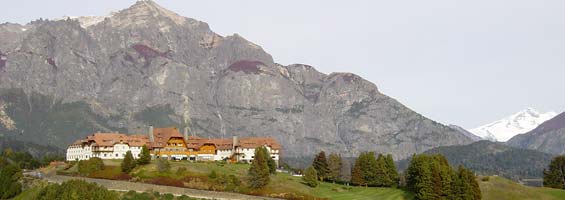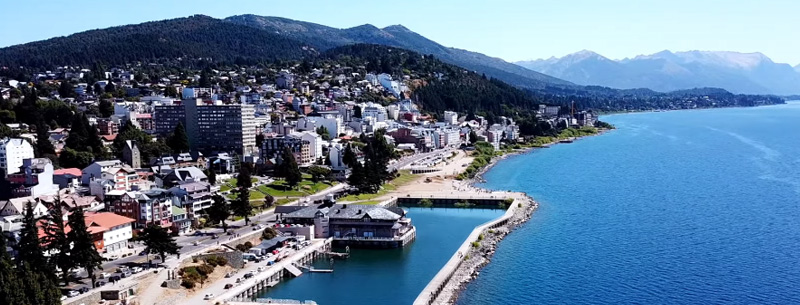Bariloche Argentina Travel Guide
San Carlos de Bariloche is a city located in the Rio Negro province, at 770 meters above sea level and at 1,680 kilometers away from Buenos Aires. Bariloche is one of the main tourist destinations in Argentina, is known as a popular winter and summer resort in the Argentinian Andes. The city es surrounded by forests, beautiful lakes such as Nahuel Huapi, Gutiérrez Lake, Moreno Lake, Mascardi Lake, and splendid mountains with snow-capped peaks, such as the Tronador, Cerro Catedral, Cerro López.

The winter season from June to September brings the stunning snow and the time of winter sports such as snowboard, snow polo, paragliding, and mostly skiing. The main mountain is Cerro Catedral, 18 kilometers away from the city, this resort features 67 km of rinks, cable cars, hotels, shopping centers, rental of the equipment, and general assistance, another good skiing destination is Cerro Chapelco in San Martin de Los Andes. The mountains feature trails for skiers of every level. In the summer, Bariloche becomes in a major destination for an outdoor sport such as water sports, fishing activities, hiking, biking, trekking, climbing, golfing, including trips to Chile via the lakes route.
Bariloche Attractions
Bariloche is a very lively town, the Civic Centre, is the most representative spot of the city, it reminds a Swiss village, its buildings lodge the City Council, the Police, the Cathedral, the Clock Tower, the Patagonia Museum, the Library, the tourist area of Bariloche, is located near the Civic Centre, the main shopping and business are on Mitre Street, Moreno street and intersections. There are many chocolate shops, restaurants, and fast-food outlets, tourist agencies, and shows, tourist can learn more about the history of Bariloche visiting the Patagonia Museum located in the center of the Civic Centre.
Cathedral Nuestra Señora del Nahuel Huapi
Tourists can visit the Cathedral Nuestra Señora del Nahuel Huapi, it has interesting vitraux that mixes religious subjects with Patagonian items. In Beschtedt Street, tourist can visit one of the most antique buildings, the Capilla de la Inmaculada (literally Chapel of the Immaculate), built in 1905, was initially settled in Moreno Street and moved to its current location using rails, during 1973, it has been declared a Historic Monument.
Bariloche Cerro Catedral
Is located 19 k.m. from San Carlos de Bariloche, is one of the most important ski resorts, it is inside the Nahuel Huapi National Park with the magnificent view of the Nahuel Huapi Lake, is a lovely place to practice snow sports in the winter season, in summer, the mountain paths are open for hiking, riding, biking, climbing, and many other adventure sports.
Cerro Tronador
Tronador (Thunderer) is an extinct volcano, named for the roaring sound produced by the constant breaking of ice falling from the mountain’s peak, it has 3,491 meters above the sea level, is an excellent challenge to climbers.
Llao Llao Municipal Park
Is a natural protected reserve of native forest and fauna, with 1,200 hectares, here one can find the Llao Llao Peninsula and Conejos Island, and forests of coihues, cordilleran cypresses, native bushes, canes, climbing plants, mosses, and ferns, it is also home of diverse species of birds, reptiles and mammals
El Bolsón
Is a picturesque and vigorous community in the middle of the fertile Valle Nuevo, at the foot of the Piltriquitron Mountain, there is a handcraft fair offering a wide range of local products, el Bolsón is famous for its jams, cheese, beer, and chocolates
Cerro Otto
The Cablecar (tel. 02944/441035) will carry you to the top of Cerro Otto, at an elevation of 1,450 meters, with impressive views of Lake Nahuel Huapi, the Llao Llao Peninsula, and the high peaks of Catedral and Tronador, as well as diversions as skiing, paragliding, trekking, climbing, dog-sledding.
Arrayanes Forest
The Arrayanes forest is located on Peninsula Quetrihué, home of magnificent arrayán trees that only grows here.
Histórico Tren a Vapor (Historical Steam Train)
The train follows the Nahuel Huapi shoreline, a unique steppe landscape, its first stop at Ñirihuau station, a panoramic point to admire the Catedral and Tronador mounts, and other natural wonders, in a trip in a historical train.
History of Bariloche
Bariloche comes from Vuriloche (“people from behind the mountain”) in the Mapuche language, this majestic region is formed by abundant precipitations, wide watersheds, exuberant vegetation, a wide variety of natural pastures, a rich fauna, including guanacos, ñandues, huemules, percas and huillines. The man appeared here, between ten and thirty thousand years ago, during the higher Paleolithic Period, after glaciations burst into the valley, testimony of this are the findings of rock paintings of hands, similar to the ones found in Europe.
Tehuelche tribes from the south, the Puelche from the east, and the Pehuenche from the north lived here in peaceful coexistence, until the second half of the 17th century, with the arrival of the Araucanos, who absorbed this tribe. Araucanos imprinted their culture to all those people living in Patagonia. Spaniards in their conquering anxiety, penetrate gradually in this territory of lakes, Since 1653, Jesuits tried to start their evangelizing mission traveling around the region. For more than a century there was no more news from this area, until 1872, when the naturalist Francisco Pascasio Moreno arrived to the Nahuel Huapi, and traveled extensively the region; Moreno had the idea to create a national park to protect this wonderful area, being the first white man who came from the Atlantic to devote himself to studying and investigating this spectacular environment. In the 1880s, the Argentine army advanced on the region with the mission of reconnoitre the territories to this geography, in this time the remaining Indian Culture was subdued totally.
Carlos Wiederhold a German trader, established the first store in 1895, the first tourists arrived in summer 1902 and stayed at this store. The city was officially founded on May 3, 1902, it was named San Carlos de Bariloche, in honor of Mister Wiederhold and the Indian term Vuriloche. By 1909, there were 1,250 inhabitants.
The first road for cars was completed in 1913, thanks to the US president Theodore Roosevelt. In 1921 the first plane arrive from San Fernando, Buenos Aires. In the 1930s the first train arrived, by this time also, were built the Civic Centre, including several important buildings such as the Library, the Theatre, the Cathedral, the San Eduardo Church, the Llao Llao Hotel, and others. Bariloche became as the favorite place for aristocratic tourism, receiving the visit of the Duke of Kent and his brother Edward Windsor, Prince of Wales, who, time later, became King Edward VIII of England.
In 1934, the Nahuel Huapi National Park was created. In 1940, with flights taking 7 hours and making two stops, the air service from Buenos Aires to Bariloche began. Currently, the great majority of its current inhabitants are descendants of foreigners. Swiss, Germans, Austrians, and Italians came from Europe to settle in these beautiful surroundings.
